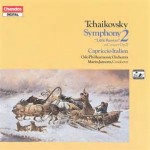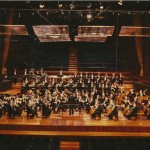Recording the Tchaikovsky Symphonies | Part Four
Tchaikovsky: Symphony No. 2 in C minor, op. 17 “Little Russian”
Now that we had three of the Tchaikovsky symphonies on tape – by this time two had been released, and the 1st Symphony was due for release in the late fall of 1985, the orchestra and the
Chandos recording team had developed a routine – record – plan – and record. The decision for the next recording project was made at the conclusion of the recording sessions for the 1st Symphony, which finished up on the very last day of April 1985.
By that date, we knew that we would be recording the Second Symphony, Tsiolkovsky’s Opus. 17, subtitled “Little Russian”. We also knew that we would be recording it in September of 1985, and that we would be performing it in concert and then recording it, which turned out to be the way we did all future recording projects.
The symphony is my favorite of the three earlier symphonies, and it is notable for a beautiful introduction based on a “Little Russian” melody intoned by the solo french horn, a march-like andante in which the timpani sets the pace with a two-bar opening solo getting softer and serving as an ostinato for several bars; a healthy scherzo, and a hell-for-leather finale.
The challenges
Like the First Symphony, though for different reasons, it has its challenges, both in terms of performance, and in getting it on tape. The challenge for Mariss and the orchestra would be to get the essence of the work and the technical details in order quickly, as we would not have all the rehearsal time that we had with the symphonies previously recorded. This time there would be other works to rehearse, as there were a pair of concerts happening during the recording week. We would have the Friday and Saturday of that week to get it all on tape, and it had to be done by that Saturday afternoon.
Complicating matters was the fact that Mariss chose to perform Igor Stravinsky’s “Symphony of Psalms” on the first half of the program, so we had to divide our time between the symphony and the Stravinsky as equally as possible.This turned out well in the event, as Mariss is an exceptionally good rehearsal conductor – and he made the most of our Monday rehearsal. By Tuesday’s lunch break, the symphony was in everybody’s head and hands, and we were able to do justice to rehearsing the Stravinsky. The two concerts helped keep our focus on the Tchaikovsky, and we were more than ready.
Another challenge that presented itself was more in my court, so speak. It had to do with the replacement of the Ludwig timpani that had been serving as the orchestra’s second set. I had been dissatisfied with that set since my audition period, and secretly vowed to try and replace them as soon as I could if I won the audition and became a permanent member of the orchestra. Once I had become a member, and after serving out my probationary period, I initiated talks with the management to see what could be done to set the process in motion. Ideally, it would have been great to get another set of Hingers to replace the Ludwigs, but that was not possible at the time for financial reasons. We worked out a deal in which we would gradually replace the Ludwigs over a period of three or four seasons. We’d start by ordering in the innermost pair of timpani. I chose to order a pair of Metropolitan B Dresden-style timpani from the American Drum Mfg. Co. (founded by Walter Light, and owned and managed by his son Marshall). They arrived in Oslo two weeks before the recording was to take place. Trygve and I got them out of the packing crates and we cleaned and tuned them up. We thought they sounded just great, and as a matter of fact, they did. We spent a couple of hours on stage with them set up next to the Hingers, and played them in, each of us taking a turn and the other one going out into the hall to listen and make comments. The bowls on them were of the sem-flat design, and they spoke very directly and clearly. We were quite pleased with the sound, and as a result of our testing, I made up my mind to use them somehow in the recording sessions. After some thought, I decided to use them in the second movement, which calls for two timpani tuned to B flat and e-flat. For the concerts, and most of the symphony in the recording, I used the Hingers, but when it came time to record the second movement, I set up the Lights next to the Hingers and played the second movement on them. I was taking a gamble on the result being up to expectations. More about this later.
The Sessions….
The sessions took place, as I noted, in September of 1985. This turned out to be a very busy recording period for the orchestra. The two weeks prior to the Tchaikovsky concerts and sessions were taken up by recording contemporary Norwegian music under the direction of Osmo Vänska, followed by a week recording the Bruckner 9th Symphony, with sketches for a finale and a completion done by William Carrigan. This we recorded for Chandos, under the direction of guest conductor Yoav Talmi. (More about that in another post.)
The symphony was recorded at the tail end of a concert week that included Stravinsky’s wonderful “Symphony of Psalms” on the first half of the concert, with the “Little Russian” being played as the final work of the concert. Recording sessions took place on the Friday and Saturday of that week – and the fact that the symphony was rehearsed and “played in”for concerts as well as recording aided us enormously in getting the work recorded in only two sessions.
The recording team was the same as for the Fourth and First Symphonies – Brian and Ralph Couzens from Chandos, and Dag Kristofferson was again the recording engineer from NRK.
The first movement begins with a Little Russian folk tune, “Down by Mother Volga”, and I remember vividly how beautifully our solo horn player, Odd Ulleberg played it, with just the right touch of melancholy. The rest of the movement went on tape rather quickly and rather well.
The second movement provided me the first of several challenges. Instead of a lyrical slow movement, Tchaikovsky resurrected a bridal march from an opera that he composed three years previously. The opera was called “Undine”, and it was ultimately rejected. In its symphonic guise, it starts off with the timpani playing quarter-notes (crochets) on the notes E-flat and B-flat, diminishing in volume over two bars until the orchestra comes in. It is a lonely moment and one needs to be spot on pitch wise. As I mentioned above, for the concerts, I played the symphony in its entirety on the Hingers. I had decided that for the recording, I would have the Light Metropolitan Bs set up for the second movement for the recording session. I made sure that they were cleared, and I used a pair of Feldman medium-generals with a bit of an edge in order to avoid too “fuzzy” a tone. All went well with regard to playing and the movement as a whole went on tape fairly quickly. However, during the playbacks and after the release of the record, I initially felt that my enthusiasm got the better of me. I felt at the time that the sound of the Lights was so much sharper than the Hingers, which had a warmer, more mellow sound. This was due to two factors: The Lights were equipped with Remo insert-ring hazy heads, rather than the standard Remo hazy extended collar heads used on the Hingers. Second, the edge of the kettle on the Lights was much sharper than that on the Hinger drum. I felt that the sound of the Lights on the second movement (shortly after the event) was different enough to stand out like a sore thumb, That was at the time. As I write this blog post, I am listening to the recording, and am marveling at how well it all sounds. No “sore thumb here!” Even at a removal of thirty years, I am breathing a sigh of relief!
The scherzo went on tape fairly quickly, although as with all movements, Mariss paid great attention to detail and made sure the results were good before approving the final results.
The Wild Ride of The Finale!
Let me come out straight and say it – the finale was the most challenging and the most exhilarating of the four movements to play and record. My colleagues Per Erik Thorsen and Per Melsæter joined us for the finale, which is the only movement that calls for percussion other than timpani. They managed the bass drum, cymbals and tamtam magnificently, adding just the right amount of color and rhythmic edge. The timpani part is tuned to G, A-flat and c as written in the original, and can be played (and usually is) on three drums. However, Mariss rewrote the timpani part thirteen bars before the coda. He had me double the bass line (winds and brass)with the following sequence – f-sharp-e-flat-c-a natural-e-flat-a-flat-c-rolling for three bars on the c – then f-sharp -roll. This necessitated the use of extra drums. I put the e-flat on the 22 and a half inch Hinger, and since I had the 20 inch Hinger (used in the Stravinsky), I used that for the high f-sharp. t pedaled between the A-flat and
A-natural on the 28 inch. The c stayed where it was, on the 25 inch. I must admit that it felt a little strange to play it this way, but the funny thing is, after repeated listening, it grew on me. The high f sharp makes it sound a little oriental, but having that 20 inch was godsend as there was no time for elaborate pedaling.
The major challenge of the balance of the movement and the coda was to properly coordinate the drum-to-drum action. The tuning scheme is G on the 31 inch, A-flat on the 28 inch, and c on the 25 inch (all measurements refer to the Hinger drums). While this works, it is difficult to get a proper drum to drum coordination between the c and the G, especially with having to hop over the 28 inch A-flat. Most players today would probably put the tuning scheme as follows: A-flat, G, and c. I know that I did a little bit of surreptitious pedaling to avoid hopping over the 28 inch.
Another challenge is the extremely fast coda. Here, Tchaikovsky takes no prisoners when it comes to tempo. Here, as elsewhere in this movement, you count for dear life and tighten your belts! This is where the drum to drum coordination can get sticky if one is not careful. Fortunately, I kept my head, and the result for all of us was a great final product. A wild ride indeed, and one of them most exhilarating experiences of my musical life!



Recent Comments